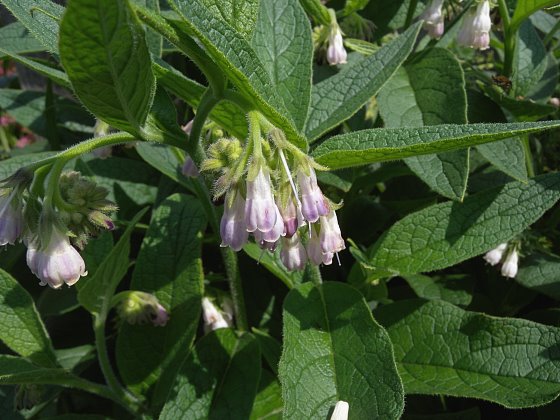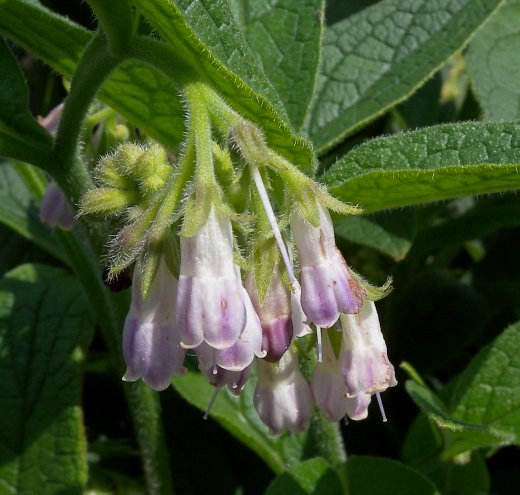
Nodding cymes of flowers about ¾-2" across terminate the upper primary stems and lateral stems below. The peduncles and pedicels of these cymes are light green to purplish green and hairy; individual peduncles are 1-3" long, while individual pedicels are about ¼-½" long. The flowers are about ¼" across and ½" long (or slightly longer). Each flower has an elongated campanulate corolla (white, pink, or purple), a hairy green calyx with 5 lanceolate teeth, 5 inserted stamens, and a pistil with an exerted style. The calyx is about one-half the length of the corolla. Along the outer rim of the corolla, there are 5 small lobes that are recurved. The blooming period occurs from late spring to mid-summer, lasting about 1 month. Afterwards, each flower is replaced by 4 nutlets. Individual nutlets are about 4-5 mm. in length, dark brown or black, ovoid in shape, and somewhat flattened toward one end. The root system consists of a stout taproot that is dark brown.
Cultivation: The preference is full sun to light shade, moist to mesic conditions, and fertile soil containing loam. There are few problems with insect pests and disease organisms.

Range & Habitat: Common Comfrey has naturalized in NE Illinois and scattered counties elsewhere within the state (see Distribution Map). Such naturalized plants are uncommon. Common Comfrey was introduced into North America from Eurasia as a medicinal herb. It is still cultivated in gardens. Habitats include damp grassy meadows, riverbanks, vacant lots, areas along roadsides and railroads, ditches, and waste areas. Areas with a history of disturbance are preferred.
Faunal Associations: For North America, little is known about floral-faunal relationships for this plant. According to Müller (1873/1883) in Germany, nectar-seeking long-tongued bees are the primary pollinators of the flowers, particularly bumblebees and Anthophorine bees (Anthophora spp.); sometimes bumblebees steal nectar by chewing holes near the corolla bases of the flowers. Müller also reported that honeybees, Halictid bees, and a Syrphid fly (Rhingia sp.) would also steal nectar from the corolla holes that were created by bumblebees. Common Comfrey is somewhat toxic to mammalian herbivores and humans because it contains pyrrolizidine alkaloids. Over a period of time, these alkaloids can cause irreversible liver damage if the foliage and especially the roots are consumed in sufficient quantity. Horses, cattle, goats, and pigs are susceptible to being poisoned; apparently sheep are more resistant to adverse reactions.

Photographic Location: A garden in Urbana, Illinois.
Comments: The foliage of Common Comfrey is somewhat similar to other species in the Borage family, particularly Lithospermum latifolium (American Gromwell), Lithospermum officinale (European Gromwell), and Borago officinalis (Borage). However, the flowers of Common Comfrey have campanulate (bell-shaped) corollas with open throats, while the flowers of American Gromwell and European Gromwell have narrow throats. The flowers of Borage are even more distinct with their widely spreading petals and sepals; these flowers are also wider, spanning about ¾-1" across when they are fully open.